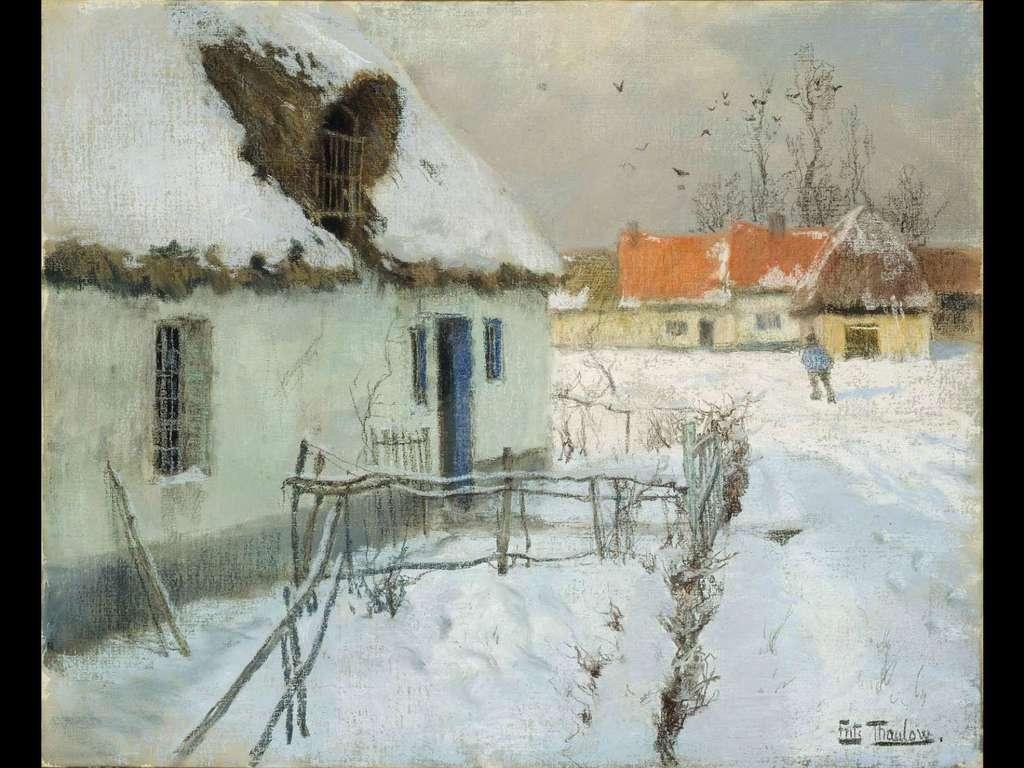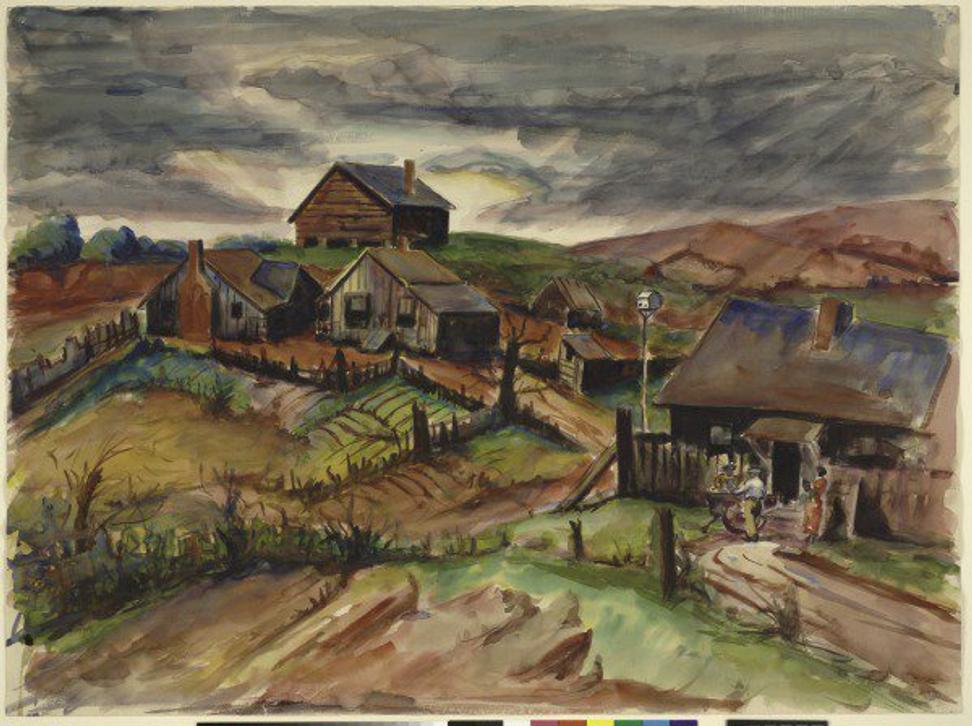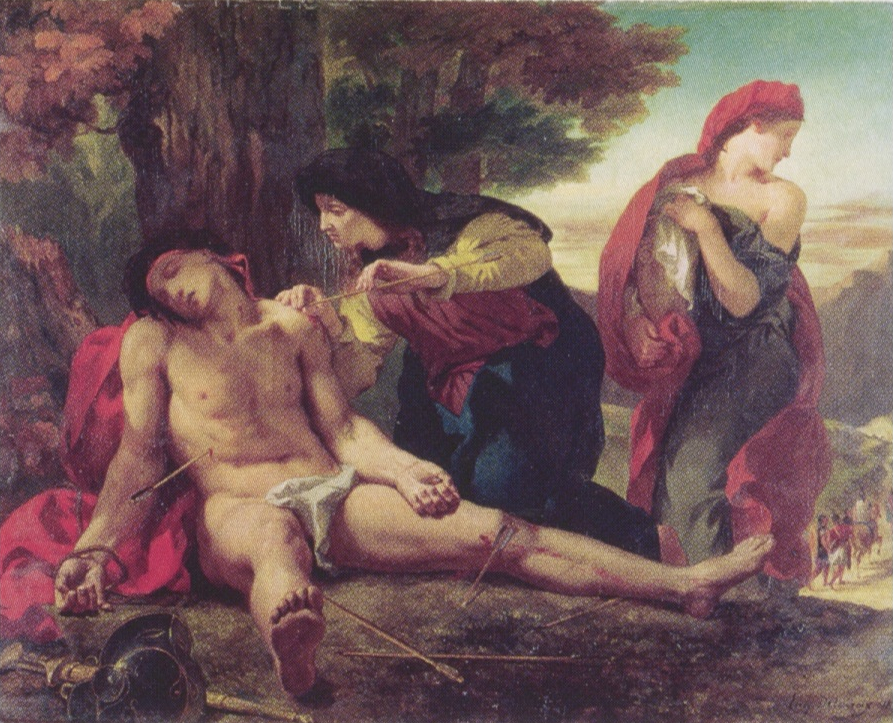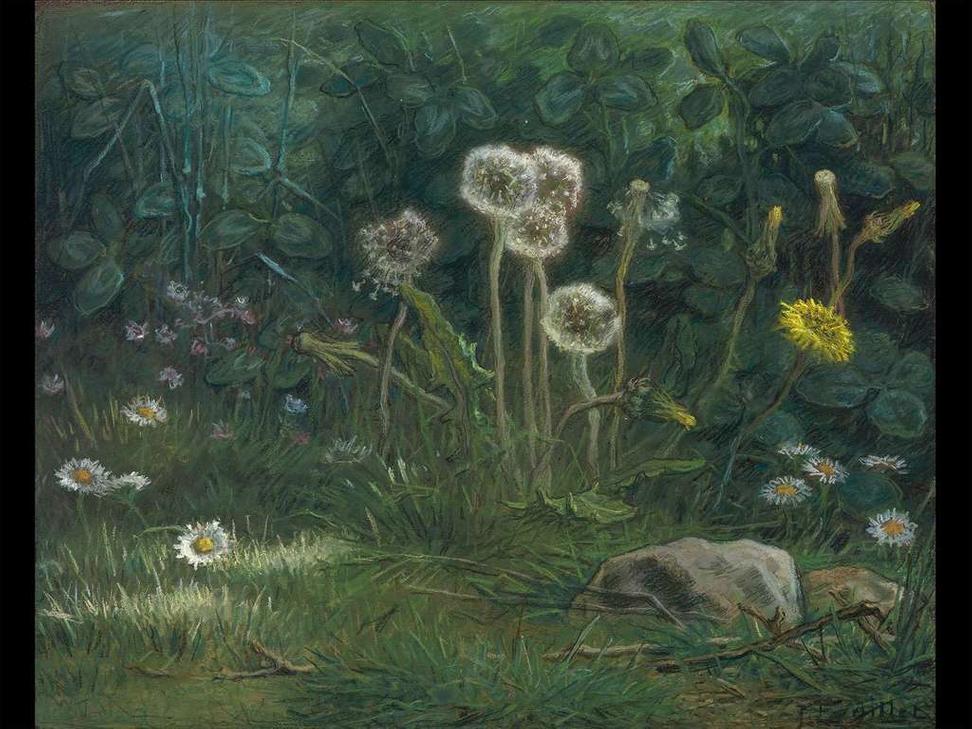The fragility of powdery pigment and the light sensitivity of
the paper on which it rests mean pastels can rarely be
exhibited—typically for only a few months per decade.
French Pastels: Treasures from the Vault at
the Museum of Fine Arts, Boston (MFA), provides an opportunity to see
nearly 40 masterworks by 10 avant-garde artists who reinvigorated the
challenging medium in the 19th century, from depictions of rural life by
Jean-François Millet to portrayals of ballerinas by Edgar Degas.
Drawn
primarily from the MFA’s holdings and supplemented by key loans from a
private collection, the exhibition is organized thematically, showcasing
artists’ use of the colorful sticks of ground pigment to capture the
ephemeral—fleeting expressions of the face, the movement of fabric or
atmospheric effects—and beauty in the mundane. Pastel, which required
none of the drying time of oil paint, was perfectly suited to these
aims. New and bold colors, made possible by the advent of synthetic
dyes, encouraged experimentation in the mid-19th century, and Millet and
Degas were among the leading innovators. In addition to exploring their
techniques and artistic processes, the exhibition also highlights works
by their contemporaries: Mary Cassatt, Léon-Augustin Lhermitte, Edouard
Manet, Claude Monet, Camille Pissarro, Odilon Redon, Pierre-Auguste
Renoir and Johan Frederik Thaulow.
French Pastels: Treasures from the Vault is on view from June 30, 2018 through January 6, 2019 in the Charlotte F. and Irving W. Rabb Gallery.
“To really appreciate how astonishing these pastels are—the
extraordinary variety of surfaces and marks achieved with this
beautiful, colorful dust—you really have to spend time with them, up
close and in person, and that’s a very rare opportunity to have,” said
Katie Hanson, Assistant Curator of Paintings, Art of Europe.
Millet developed his pastel practice in the mid-1860s, producing
luminous, evocative views of shepherds, farmyard and country themes that
employed the versatile medium to dazzling effect. His depictions of
flowers and grass present them from the point of view of a bug or small
animal, intimate in their proximity, lush in their details and color.
Pastel covers the sheet in
Dandelions (1867–68), showing no
glimpse of sky save for the bright patches of light touching the grass
and the little white blossom at lower left.

In
Primroses (1867–68),
the cowslip primroses glow, brilliant yellow amid the dense darkness of
the forest floor, while a slug with a glistening antenna moves along
the rough earth.

In
Shepherdess with her Flock and Dog (1863–65),
the artist imbues a sense of monumentality to the contemplative figure
of the young shepherdess, delicately balancing luminous pastel with dark
conté crayon to convey sunlight peeking from behind the clouds above,
illuminating the herd yet leaving the peasant’s downturned face
in shadow.
Nearly all of Millet’s late pastels were commissioned by Emile Gavet,
an architect and arts patron who provided him with a monthly stipend
and drawing supplies. Following Gavet’s financial downturn, his
collection of nearly 100 pastels by Millet was sold at the Hôtel Drouot
in June 1875. Twelve of the works on view in the exhibition were
included in this historic auction, which was a revelation for artists at
the time. “When I entered the room at Hôtel Drouot where they were
exhibited,” wrote the awe-struck Vincent van Gogh, “I felt something
akin to: Put off thy shoes, for thou standest on holy ground.”
Degas also experimented boldly with pastel, using processes that
still elude explanation. In the exhibition, works from across more than
three decades of his career highlight his inventiveness. They include
four pastels depicting his most famous subject—ballerinas, whose lives
he explored and portrayed on stage, in rehearsals and backstage in
private moments. Degas achieved a great range of effects in these works.

In
Dancers Resting (1881–85), he rendered the glints of light
on the ballerinas’ hair with small, linear strokes, the opaque outer
skirts with broader, heavier strokes, and the puffy underskirt by
rubbing the medium diffusing the pigment either with his hand or a rag.

In
Dancers in Rose (about 1900), however, the encrusted pastel
takes on the appearance of a dense fabric, rather than a light airy
powder. Degas also often worked in a cumulative way, changing the scale
of the page with strips of paper before having it mounted onto a firm
surface.
In
Seated Dancer (1895–1900, Isabelle and Scott Black
Collection), he revised his composition as he worked—viewers can note
the repositioning of the dancers’ legs and the modification of the size
and shape of the paper itself, with strips added at both sides. These
pastels bring visitors close to the artist’s process through their
visible strokes and seams.
While renowned as a great portrayer of people and urban
entertainments, Degas was also a landscapist. The exhibition includes
two of his distinctive color monotype landscapes, created in an unusual
process. The artist applied paint or printers’ ink onto a metal plate,
placed a dampened sheet of paper on top of it, and ran it through a
printing press. Degas left some of his monotypes as they came off the
printing press, but enhanced and modified the two works on view with
pastel once the printed matrix had dried. The exhibition also includes
landscapes by Monet, from an early moment in his career when he was just
beginning to work
en plein air, and his Norwegian friend Thaulow, who used pastel to depict the powdery blowing snow, harmonizing medium with motif.

Johan Frederik Thaulow, Cottages in the Snow, 1891. Pastel on canvas.
Bequest of David P. Kimball in memory of his wife Clara Bertram Kimball.

Additional notable works on view include Pissarro’s
Poultry Market at Gisors (1885),
which hovers between the effect of painting and drawing and was given
by the artist to Monet in exchange for one of his canvases, as well as
the work of Mary Cassatt, shown alongside a box of pastels once used by
the artist.
Good review, lots more images

![Image result for [[["xjs.sav.en_US.y5vqFNLwkD0.O",5]],[["id","type","created_timestamp","last_modified_timestamp","signed_redirect_url","dominant_color_rgb","tag_info","url","title","comment","snippet","image","thumbnail","num_ratings","avg_rating","page","job"]],[["dt_fav_images"]],10000]](https://pbs.twimg.com/media/Dflaa2WXcAIZxvB.jpg)
![Image result for [[["xjs.sav.en_US.y5vqFNLwkD0.O",5]],[["id","type","created_timestamp","last_modified_timestamp","signed_redirect_url","dominant_color_rgb","tag_info","url","title","comment","snippet","image","thumbnail","num_ratings","avg_rating","page","job"]],[["dt_fav_images"]],10000]](https://pbs.twimg.com/media/DgU7OQrXkAIBqKJ.jpg)
.jpg)





![Image result for [[["xjs.sav.en_US.y5vqFNLwkD0.O",5]],[["id","type","created_timestamp","last_modified_timestamp","signed_redirect_url","dominant_color_rgb","tag_info","url","title","comment","snippet","image","thumbnail","num_ratings","avg_rating","page","job"]],[["dt_fav_images"]],10000]](https://i.pinimg.com/originals/be/f1/02/bef1029ccae6097992b7613eefb7d0bd.jpg)


![Image result for [[["xjs.sav.en_US.y5vqFNLwkD0.O",5]],[["id","type","created_timestamp","last_modified_timestamp","signed_redirect_url","dominant_color_rgb","tag_info","url","title","comment","snippet","image","thumbnail","num_ratings","avg_rating","page","job"]],[["dt_fav_images"]],10000]](https://images.graph.cool/v1/cj6c28vh912680101ozc2paxj/cjezwkjy00qr40140po8ns0e6/18x93:1199x629/1200x630/300_mu_vsb_sanantonio_05_zuloaga.jpg)
![Image result for [[["xjs.sav.en_US.y5vqFNLwkD0.O",5]],[["id","type","created_timestamp","last_modified_timestamp","signed_redirect_url","dominant_color_rgb","tag_info","url","title","comment","snippet","image","thumbnail","num_ratings","avg_rating","page","job"]],[["dt_fav_images"]],10000]](https://i.pinimg.com/originals/91/67/e4/9167e45b685d7ed0cdbb948d58553220.jpg)




![Image result for [[["xjs.sav.en_US.y5vqFNLwkD0.O",5]],[["id","type","created_timestamp","last_modified_timestamp","signed_redirect_url","dominant_color_rgb","tag_info","url","title","comment","snippet","image","thumbnail","num_ratings","avg_rating","page","job"]],[["dt_fav_images"]],10000]](https://www.christies.com/media-library/images/features/articles/2016/05/26/constable-view-on-the-stour-near-dedham/john-constable-sketch-for-view-on-the-stour-near-dedham-1821-22.jpg?w=780)
![Image result for [[["xjs.sav.en_US.y5vqFNLwkD0.O",5]],[["id","type","created_timestamp","last_modified_timestamp","signed_redirect_url","dominant_color_rgb","tag_info","url","title","comment","snippet","image","thumbnail","num_ratings","avg_rating","page","job"]],[["dt_fav_images"]],10000]](https://secure.i.telegraph.co.uk/multimedia/archive/02264/John_constable_pai_2264381b.jpg)


![Image result for [[["xjs.sav.en_US.6670U8Vb0m4.O",5]],[["id","type","created_timestamp","last_modified_timestamp","signed_redirect_url","dominant_color_rgb","tag_info","url","title","comment","snippet","image","thumbnail","num_ratings","avg_rating","page","job"]],[["dt_fav_images"]],10000]](http://brightcove04.o.brightcove.com/104524641001/104524641001_3903120867001_canaletto-BC.jpg?pubId=104524641001&videoId=3899589233001)


![Image result for [[["xjs.sav.en_US.y5vqFNLwkD0.O",5]],[["id","type","created_timestamp","last_modified_timestamp","signed_redirect_url","dominant_color_rgb","tag_info","url","title","comment","snippet","image","thumbnail","num_ratings","avg_rating","page","job"]],[["dt_fav_images"]],10000]](https://www.christies.com/img/LotImages/2013/CKS/2013_CKS_01136_0051_000(giovanni_antonio_canal_called_canaletto_the_molo_venice_from_the_bacin).jpg)
![Image result for [[["xjs.sav.en_US.y5vqFNLwkD0.O",5]],[["id","type","created_timestamp","last_modified_timestamp","signed_redirect_url","dominant_color_rgb","tag_info","url","title","comment","snippet","image","thumbnail","num_ratings","avg_rating","page","job"]],[["dt_fav_images"]],10000]](http://p5.storage.canalblog.com/53/69/119589/31664359.jpg)
![Image result for [[["xjs.sav.en_US.y5vqFNLwkD0.O",5]],[["id","type","created_timestamp","last_modified_timestamp","signed_redirect_url","dominant_color_rgb","tag_info","url","title","comment","snippet","image","thumbnail","num_ratings","avg_rating","page","job"]],[["dt_fav_images"]],10000]](https://www.christies.com/img/LotImages/2000/CKS/2000_CKS_06405_0104_000().jpg)



![Image result for [[["xjs.sav.en_US.y5vqFNLwkD0.O",5]],[["id","type","created_timestamp","last_modified_timestamp","signed_redirect_url","dominant_color_rgb","tag_info","url","title","comment","snippet","image","thumbnail","num_ratings","avg_rating","page","job"]],[["dt_fav_images"]],10000]](https://imgc.artprintimages.com/img/print/print/eugene-delacroix-christ-in-the-garden-of-gethsemane-1824-27_a-l-9424457-8880731.jpg?w=550&h=550)













![Image result for [[["xjs.sav.en_US.6670U8Vb0m4.O",5]],[["id","type","created_timestamp","last_modified_timestamp","signed_redirect_url","dominant_color_rgb","tag_info","url","title","comment","snippet","image","thumbnail","num_ratings","avg_rating","page","job"]],[["dt_fav_images"]],10000]](http://www.sothebys.com/content/dam/stb/lots/L15/L15033/020L15033_85ZQS.jpg)
![Image result for [[["xjs.sav.en_US.6670U8Vb0m4.O",5]],[["id","type","created_timestamp","last_modified_timestamp","signed_redirect_url","dominant_color_rgb","tag_info","url","title","comment","snippet","image","thumbnail","num_ratings","avg_rating","page","job"]],[["dt_fav_images"]],10000]](http://www.sothebys.com/content/dam/stb/lots/L14/L14033/014L14033_6RJ94.jpg)